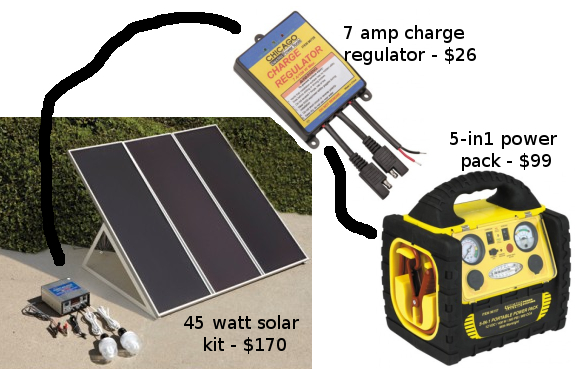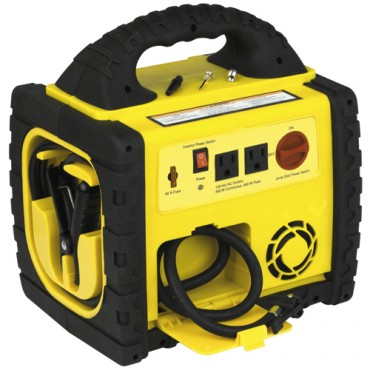
Plug and play solar backup

We still think that plug
and play is the way
to go for our cheap
solar backup, but
we've tweaked the specific components a
bit. We wanted to find a powerpack that we could pick up at a
physical store since powerpacks bought online have often been stored in
warehouses for years and have dubious longevity. We figure that
by picking one up locally, we can easily return it if it turns out to
be old.
 The
5-in-1 power pack at Harbor Freight is the best we
could find at a physical store --- it's only two thirds as voluminous
as the Duracell 600 watt power pack, holding 216 watt-hours of energy,
but the price commensurate. And the reviews are quite good ---
one user notes that his powerpack is only starting to lose its gumption
after five years of use.
The
5-in-1 power pack at Harbor Freight is the best we
could find at a physical store --- it's only two thirds as voluminous
as the Duracell 600 watt power pack, holding 216 watt-hours of energy,
but the price commensurate. And the reviews are quite good ---
one user notes that his powerpack is only starting to lose its gumption
after five years of use.
The 45 watt solar panel kit is really too big for our system, but it's
irresistible at the current sale price ($170 on Harbor Freight's
website --- print out the price page to use as a coupon at local
stores.) Since we've oversized our solar panel, we have to throw
in a $26 charge controller, bringing the total cost to just under $300
for the entire backup system.
On a sunny, summer day, our 45 watt solar panel will probably be
wasting quite a bit of juice, since it should pull in 135 watt-hours of
energy a day even in the dead of winter. I suspect that there
will be a way to capture that excess, perhaps by plugging an inverter
directly into the included power center to run electronics while also
charging the powerpack. Or, better yet, we might buy a (roughly)
$100 grid tie inverter, which would allow us to plug our solar panel
directly into an electric socket in the house and sell power back to
the grid --- no muss, no fuss, and easily detachable to plug the solar
panel into an inverter when the power goes out.
We'll update you as we experiment, but Mark is currently on his way to
pick up our components, so this phase of the project is now set in
stone.
Want more in-depth information? Browse through our books.
Or explore more posts by date or by subject.
About us: Anna Hess and Mark Hamilton spent over a decade living self-sufficiently in the mountains of Virginia before moving north to start over from scratch in the foothills of Ohio. They've experimented with permaculture, no-till gardening, trailersteading, home-based microbusinesses and much more, writing about their adventures in both blogs and books.
Want to be notified when new comments are posted on this page? Click on the RSS button after you add a comment to subscribe to the comment feed, or simply check the box beside "email replies to me" while writing your comment.

Technically, you'd be selling power back to the grid, in exchange for money. :^)
This is awesome, though!
For putting electricity back into the grid you'll also need an inverter and an MPP tracker. And you might need a different meter. Check your your local power company.
Make sure to put the panel up at the correct angle and pointed to the south. The angle between the panel and the horizontal should be equal to your latitude.
I'm assuming that the charge controller includes an MPP tracker, but you might want to check on that.
If you have energy to spare in the summer, why not e.g. run a small pump to keep your water tank topped up?
From what I understand, the grid tie inverter is all I would need to put electricity back into the grid. We do have the right kind of meter, but thinking about it this morning, I wonder if you'd even need to have that as long as you were using more energy than you were making? My very vague understanding of electricity makes me think that if you plug the grid tie inverter into a household electric socket the way the inverters are designed to be used, the electricity produced by the solar panel would be used first by the household and would just make us draw a bit less juice from the grid. Or is that too simplistic of an understanding?
Mark's going to put some thought into where to put the panel. Clearly, more research has to be done!
I hate electricity:-0, been hit one tooooooo many times. Let me start of by saying I know nothing about Solar Power. But here goes a train of thought.
One concern being tied into the grid should be for the safety of those working on the line in the event of a downed power line. Just like hooking up generators here in Fl, you have to make sure that no power will go back up the line and hurt someone working on the other end when power lines are down. Something to talk over with the power guys.
You guys are going to be totally off grid before you know it, way to go. GOOD LUCK, Yall are in our Prayers, oneoldchief